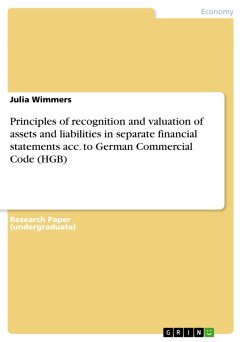Research Paper (undergraduate) from the year 2010 in the subject Business economics - Accounting and Taxes, grade: 2,3, University of applied sciences, Munich, course: MBA, language: English, abstract: Every single company is obliged to make a financial statement according to national law, which is the German Commercial Code (HGB) in Germany. This assignment elaborates important clauses for the domain of "recognition and accounting principles", lodged in the HGB and then critically monitors and analyzes rules, obligations and bans, deduced from these clauses. The author therefore looks into the subject of accounting challenges in general like the actual definition of an asset and the right classification of individual assets: which is already detected as the first "room for accounting flexibility" allowing firms to build up hidden reserves, something being highly criticized from supporters of the Anglo-Saxon approach. Next the major valuation principles and in particular the Prudence Principle with its four occurrences are analyzed, followed by a practical and value oriented overview of the "past, present and future value" approach. Additionally, the author presents a scheme with the logical "computation of acquisition costs" in order to have a valuation basis for the balance sheet. This accounting cost termination is however another "option" enabled through the legal text of § 255 HGB to minimize or maximize profits shown to external parties. The core part then focuses on the accounting differences of certain groups of assets. For theoretical reasons calculation scenarios with corresponding formulas for the depreciation methods are introduced and executed with a practical example, namely the depreciation for a ten year old machine. This simple example proves that the linear method allows the highest profit shown whereas with the declining method the lowest profit is shown. In the last chapter important aspects and challenges, as the deciding role of the correct "amount to be paid" for the subject of accounting of liabilities are analyzed.
Dieser Download kann aus rechtlichen Gründen nur mit Rechnungsadresse in A, B, BG, CY, CZ, D, DK, EW, E, FIN, F, GR, HR, H, IRL, I, LT, L, LR, M, NL, PL, P, R, S, SLO, SK ausgeliefert werden.



